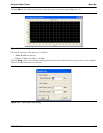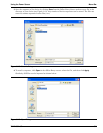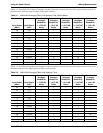
Using the Power Sensor Measurement Considerations
MA24106A UG 3-15
High Crest Factor Signals (peak to average ratio)
High crest factor signals, such as CDMA/WCDMA, may have crest factors as high as 10 dB. To ensure the most
accurate power measurement, the statistically-low peak signals should not exceed +30 dBm.
For example, if a signal has an expected crest factor of 10 dB, then the highest average power measured should
not exceed +20 dBm. A sensor’s linearity graph of a WCDMA (TestModel_5_8HSPDSCH) signal with 10 dB
crest factor is shown below:
Multitone Signals
The MA24106A is a True-RMS sensor that can measure very wide bandwidth modulation without much
restriction. The only limitation is the frequency flatness of the sensor. Because the sensor’s sensitivity is not
identical for all frequencies and when measuring multi-tone signals, the frequency entered into the sensor’s
application should be the average frequency of all significant tones. The MA24106A has an error of 0.01 dB for
every 100 MHz bandwidth at frequencies below 3 GHz, and an error of 0.03 dB for every 100 MHz bandwidth
at frequencies above 3 GHz.
For example, a dual tone signal of 2.0 GHz and 2.2 GHz may have an additional measurement error of 0.02 dB
(0.01 dB × 2) when the application frequency is set to 2.1 GHz.
Noise and Averaging
When there is a need to achieve a required reading resolution, particularly at low power levels, averaging is
often needed to reduce noise and steady the displayed power reading. Use the noise vs. resolution table in the
sensor manual (Using the Power Sensor|Making Measurements|Optimizing the Readings) to determine the
number of averages that will typically be required for a given resolution. Alternatively, determine the number
of averages through calculation by using the noise specifications and the fact that noise will be proportional to
the square root of N, where N is the number of averages.
Figure 3-20. Sensor Linearity Graph
2GHz WCDMA Linearity
TestModel_5_8HSPDSCH
-0.7
-0.6
-0.5
-0.4
-0.3
-0.2
-0.1
0.0
0.1
0.2
0.3
0.4
0.5
0.6
0.7
-40-30-20-10 0 10 20
Input Power (dBm)
Variance (dB)


















